Air Tanzania
|
| |||||||
| |||||||
| Founded |
11 March 1977 (as ATC) December 2002 (Restructured) | ||||||
|---|---|---|---|---|---|---|---|
| Commenced operations |
1 June 1977 (as ATC) 31 March 2003 (as ATCL) | ||||||
| AOC # | 001 | ||||||
| Hubs | Julius Nyerere International Airport | ||||||
| Fleet size | 5[1] | ||||||
| Destinations | 13 | ||||||
| Company slogan | The wings of Kilimanjaro | ||||||
| Parent company | Tanzanian Government (100%) | ||||||
| Headquarters | Air Tanzania House, Garden Avenue, Kivukoni, Dar es Salaam, Tanzania | ||||||
| Key people | Mr. Ladislaus Matindi(CEO) | ||||||
| Total equity | TSh 13.4 billion [US$8.06 m] | ||||||
| Website | Company Website | ||||||
Air Tanzania Company Limited (ATCL) (Swahili: Kampuni ya Ndege ya Tanzania) is the flag carrier airline of Tanzania based in Dar es Salaam with its hub at Julius Nyerere International Airport. It was established as Air Tanzania Corporation (ATC) in 1977 after the dissolution of East African Airways and has been a member of the African Airlines Association since its inception.[2] The airline was wholly owned by the Tanzanian Government until 2002 when it was partially privatised as per the directive of the Bretton Woods Institutions to implement the country's Structural Adjustment Program. The government therefore reduced its shareholding to 51 percent and entered into a partnership with South African Airways.
The partnership lasted for about four years and had accumulated losses of more than Tsh 24 billion (US$19 million). The government repurchased the shares in 2006 and it is once again a wholly owned government company. Over the years, it has served a variety of domestic, regional, and intercontinental destinations. Despite being the national airline, its market share has deteriorated over the years from 19.2 percent in 2009 to 0.4 percent in 2011.[3]
In 2016 the Tanzanian government under the leadership of President Dr. John Pombe Magufuli initiated a new drive to revive the national carrier, as part of a pledge made during the election campaigns the previous year. The government purchase two brand new Bombardier Q400 for the national carrier which were delivered in September 2016. In December the same year the President's office announced that a further four aircraft would be purchased for the national carrier, with deliveries set for June 2018.[4] As of reports issued by August 2018, Air Tanzania's market share for 2017 went up to 24% from 2.5% the previous year.[5]
History
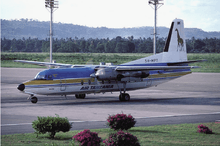
ATC (1977–2002)
Air Tanzania Corporation (ATC) was established on 11 March 1977 after the break-up of East African Airways (EAA), which had previously served the region. The liquidation of EAA followed its accumulation of US$120 million of debt.[6] Before its formation, EAA had served the region since 1946 during the British rule of East Africa. After the dissolution of EAA, Kenya and Uganda also formed their own flagcarriers: Kenya Airways and Uganda Airlines respectively.
According to Andy Chande, the founding chairman of the board, Tanzania and Uganda did not receive a fair share of the former carrier's assets despite being equal partners. The airline commenced operations with a Douglas DC-9-32 leased from Kenya Airways and purchased an additional two Boeing 737, financed by a US bank.[7] It also leased aircraft from Air Madagascar. Four Fokker F27s and four DHC-6-300 Twin Otters were added in 1980. Because of less demand, two of the Fokker 27s were made obsolete in the year 1981. These aircraft returned to service in the year 1983 but were once again removed. [8]
In May 1991, Air Tanzania began operating a Boeing 767-200ER that was leased from Ethiopian Airlines, but this aircraft proved to be too large and was returned to the lessor in February 1992.[9][10] The airline reported a profit of US$650,000 in 1994.[11]
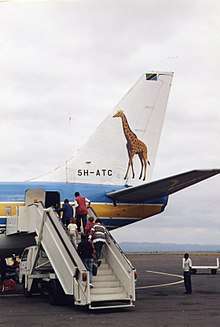
Alliance Air
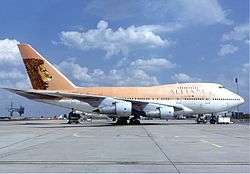
In 1994, Air Tanzania joined with Uganda Airlines and South African Airways (SAA) to form Alliance Air. Air Tanzania had a 10 percent stake in the venture.[12] Flights operated from Dar es Salaam to London–Heathrow via Entebbe on a Boeing 747SP initially, and then a smaller Boeing 767-200. This venture ceased operations in October 2000 after accumulating losses of about US$50 million. [13] The losses had been funded by Transnet, the parent company of SAA, through April 2000. When Transnet refused to continue funding the deficit, Air Tanzania accused SAA of using Alliance Air "as a Trojan Horse to take over national airlines in the region".[14] In February 2002, the government began the process of privatising ATC through the Presidential Parastatal Sector Reform Commission.[15] Advertisements were placed in the local, regional, and international media inviting potential bidders.[15] The International Finance Corporation advised the government in this transaction.[16][17] The government had approved a transaction structure that included:[18]
- Creation of a new company, "Air Tanzania Company Limited", which would be incorporated as a limited liability company under the Companies Act to take over the operating assets and specified rights and liabilities of ATC.
- A second new company, "Air Tanzania Holding Company", which would be created to take over the non-operating assets and all other liabilities of ATC.
Eight airlines submitted Expressions of Interest:[18]
- Aero Asia International (Pakistan)
- Air Consult International (Ireland)
- Comair (South Africa)
- Gulf Air Falcon (United Arab Emirates)
- Kenya Airways
- Nationwide Airlines (South Africa)
- Precision Air (Tanzania)
- South African Airways
Of the eight, four airlines carried out due diligence – South African Airways, Kenya Airways, Comair, and Nationwide Airlines.[17] By 19 September 2002, the bid deadline date, only SAA had submitted a bid. Kenya Airways and Nationwide Airlines had informed the government that they did not intend to submit bids.[17][19]
ATCL (2002–2006)

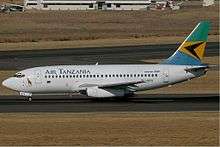
The Tanzanian government selected SAA as the winning bidder. After signing an agreement with the government, SAA in December 2002 purchased a 49 percent stake in Air Tanzania Company Limited (ATCL) for USD 20 million. USD 10 million was the value of the government's shares and the remaining USD 10 million was for the Capital and Training Account for financing Air Tanzania's proposed business plan.[17]
As the strategic partner, SAA planned to create its East African hub in Dar es Salaam to form a "Golden Triangle" between southern, eastern, and western Africa. It also intended to replace ATCL's fleet with Boeing 737-800s, 737-200s, and 767-300s. It also planned to introduce regional routes, including routes to the Middle East and West Africa. The government was expected to sell 10 percent of its 51 percent stake to a private Tanzanian investor, thereby reducing the government's ownership to a non-controlling interest in ATCL.[20]
The new Air Tanzania airline was launched on 31 March 2003, offering direct flights between Johannesburg and Dar es Salaam, but also to Zanzibar and Kilimanjaro.
Air Tanzania recorded a pre-tax loss of almost USD 7.3 million in its first year following privatisation. The loss was attributed mainly to the inability to expand the network as quickly and extensively as originally planned. It had been hoped to launch services to Dubai, India, and Europe, but these were delayed as Air Tanzania had only Boeing 737-200s in its fleet. The development of Dar es Salaam as an East African hub for the SAA alliance had also not proceeded as quickly as planned.[21]
Air Tanzania suspended on 31 January 2005 one of its few regional services, Dar es Salaam to Nairobi, following intense competition from Kenya Airways on the route. The airline, however, reaffirmed its intention to launch long-haul services within a year from Dar es Salaam to Dubai, London, Mumbai, and Muscat.[22]
The Tanzanian government announced on 31 March 2006 that it would dispose of ATCL following four years of losses, which amounted to TZS 24.7 billion. The director-general of the Tanzania Civil Aviation Authority, Margaret Munyagi, said: "Air Tanzania was in a worse state than before it was taken over by SAA." SAA, however, claimed the Tanzanian government was "not serious" for failing to release about USD 30 million, which was needed to implement Air Tanzania's business strategy to reverse continued losses.[23]
On 7 September 2006, the Tanzanian government bought SAA's 49 percent stake in ATCL for USD 1 million, hence officially terminating its partnership with SAA. The venture collapsed due to the partners' different interests in the business.[24]
Relaunched ATCL (2007 – 2015)
After the partnership between Air Tanzania and South African Airways (SAA) was officially terminated, the government set aside TZS 13 billion for Air Tanzania to start using its own ticket stock (number 197) instead of the stock of SAA (number 083), changing revenue systems and fuel services, preparing e-ticketing and accounts systems, using a new trademark, and clearing outstanding debts.[25] President Jakaya Kikwete appointed Mustafa Nyang'anyi,[26] a veteran politician and diplomat Ambassador, as the board chairman, and former Parastatal Pensions Fund director general David Mattaka as managing director and chief executive officer.[27]
In conjunction, the government also began to look for another private partner to run the airline. The first discussions began with China Sonangol International Limited in 2007, however, the discussions were ultimately unsuccessful and ended in 2010.[28] From 1 July 2007, ATCL started using its own ticket stock and began operations as a wholly owned government airline.[29]
The Parliamentary Committee on Economic Infrastructure expressed its concern about no funds being set aside for ATCL. According to the opposition, the airline has debts amounting to USD 4 million due to SAA.[30] A member of the National Assembly of Tanzania also asked the government to claim compensation from SAA for taking aircraft spare parts from the Air Tanzania hangar at the Kilimanjaro International Airport to South Africa.
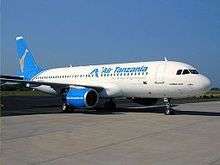
Rebranding
Air Tanzania was relaunched in September 2007 after the dissolution of the partnership with SAA with two leased Boeing 737-200s in its fleet. The new brand represented the company's name, Mount Kilimanjaro and the airline's international destinations. The introduction of the airline's new logo on a leased Airbus A320 bore the image of the imposing giraffe – Tanzania's national icon, to replace the South African Airways flag symbol.[31][32] On 1 October 2007, the revamped Air Tanzania made its inaugural flight on the Dar es Salaam to Mwanza via Kilimanjaro route.[33]
In February 2008, the carrier acquired two de Havilland Canada Dash DHC 8-Q311s. In December 2008, the Tanzania Civil Aviation Authority (TCAA) withdrew Air Tanzania's Air Operator Certificate because the airline had failed to meet the standards of the International Civil Aviation Organization. Two weeks later, the International Air Transport Association banned the air carrier from all aviation transactions and informed all travel agencies and other aviation companies to stop all transactions with Air Tanzania until further notice.[34] The certificate was restored in January 2009, with both the TCAA and Air Tanzania claiming there had never been any doubt about the airworthiness of its aircraft.[35] In 2009, Air Tanzania flew 60,018 passengers, while Precision Air moved 583,000 passengers and Coastal Aviation 141,995 passengers.[36]
Once the talks with China Sonangol International limited fell through, press reports in July 2010 indicated that Air Tanzania was in serious discussions with Air Zimbabwe to establish extensive and substantive management collaborative arrangements. Both airlines were reported to be in search of strategic partners to shore up their operations, which had been in decline over the past decade.[37]
Decline
From 2011 to 2015 the airline was in a constant period of decline, with the airline shutting down operations multiple times due to lack of aircraft. Air Tanzania was effectively grounded in March 2011, after its sole remaining operational aircraft, a Bombardier Q300 was sent to South Africa for heavy maintenance, leaving the carrier literally stranded due to the company having failed to plan forward to have a suitable aircraft leased for the duration. At the same time, the other Bombardier Q300 was undergoing a heavy C-check at ATCL's hangar at the Dar es Salam Terminal. The aircraft was stranded there due to lack of funds to import spare parts from abroad.[38] Air Tanzania resumed flying in November 2011 following the return of the aircraft. The maintenance cost USD 1 million, but other accumulated expenses brought the total bill to USD 3 million, which the Tanzanian government paid in September 2011.[39]
On November 2011 Air Tanzania had leased a Fokker F28 aircraft from JetLink Express on a standby basis in case its only operational aircraft is incapacitated. The airline assured the public that it would never cease operations again and that more aircraft would be procured over the next several months and years, according to the airline's business plan shared with the media.[39] On 21 November 2011, Air Tanzania began negotiations with Export Development Canada (EDC) to explore how EDC could assist the airline to acquire more aircraft from Bombardier, a Canadian aircraft manufacturer.[40] Those negotiations, however, failed due to the large debt the airline had.[41]
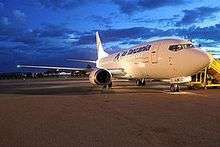
On 29 March 2012, Aerovista leased a Boeing 737-500 to Air Tanzania to enhance the airline's service delivery in the short-term.[42] In early August 2012, Air Tanzania suspended the contract with Aerovista and returned the aircraft. The only other aircraft in the fleet, a Bombardier Q300, was stored for maintenance, which caused the airline to suspend operations and rebook passengers to other carriers.[43] Air Tanzania returned to the skies on 12 October 2012 with a 32-year-old Boeing 737-200. The aircraft was leased for three months from Star Air Cargo in South Africa.[44] The 737 arrived in Dar es Salaam on 11 October 2012 in Air Tanzania livery and started operations the following day.
In late 2012, the Controller and Auditor General of Tanzania, Ludovick Utouh, recommended the criminal prosecution of three former managers of ATCL for the 2007 lease of the Airbus A320 from Wallis Trading Company, a Lebanese company. He said there were massive misappropriation and mismanagement of the leasing agreement, resulting in an accumulated debt of US$41.4 million by October 2012, all of which is guaranteed by the government.[45] The aircraft was in ATCL's possession for 48 months, but it spent 41 of those months in France undergoing a major maintenance.[46]
Air Tanzania restarted operations to Kigoma on 10 January 2013, by using its Bombardier Q300. The airline quickly expanded to domestic routes and even began to fly to Bujumbura under new management.[47][48]
In the airline's search for a new partner In January 2013, the chairman of Al Hayat Development and Investment Company (AHDIC), Sheikh Salim Al-Harthyan, announced plans for an Omani investment corporation to invest USD 100 million in Air Tanzania. The money would be used to build an airline training centre and offices for Air Tanzania, buy aircraft, and engage in other development activities that would begin before the end of 2013.[49] In August 2013, AHDIC promised to provide four Embraer 175 and four Bombardiers to Air Tanzania. The Sheikh also said that the original USD 100 million investment would be increased gradually.[50] But in May 2014, the media reported no progress had been made and that AHDIC might not be a real company.[51] Sixteen days later, however, AHDIC reaffirmed its interest in the original deal.[52]
Revival (2016 – present)
With the new government in place, Tanzania's new president John Magufuli vowed to restore the airline to its previous glory. In the 2016/2017 national budget, the government had set aside funds to purchase four new aircraft.[53] The president appointed Ladislaus Matindi as the new director general. The government makes a deal through the Tanzania Government Flight Agency to purchase two Bombardier Q400 that are to be leased to Air Tanzania.[54] In September 2016 two Bombardier Q400 planes purchased by the government of Tanzania landed at Julius Nyerere International Airport (JNIA) from Canada.[55] On Monday morning, 2 April 2018, Air Tanzania received its third and final Dash 8-400 with a tail number 5H-TCE. The aircraft was to be delivered in August last year but was seized by the Canadian contractor following government's unwillingness to settle a USD38.7 million debt awarded to Sterling by the International Court of Arbitration in 2010.[56] With the new planes, the airline resumed various suspended domestic destinations.[57]
In December 2016, the government further ordered four more aircraft, three from Bombardier and one from Boeing. The Tanzania Government Flight Agency ordered two airbus A220-300 , Q400 and one Boeing 787 Dreamliner.[58][59] On Sunday, 8 July 2018, Air Tanzania took delivery of the first of two brand new Boeing 787 Dreamliner, to be deployed on intercontinental flights. All new aircraft operated by the airline are owned by the Government Flight Agency which then leases them to the airline.[60]
Corporate affairs
Ownership
Air Tanzania is wholly owned by the Government of Tanzania. As of 30 June 2011, its share capital was about TZS 13.4 billion.[61]
Business trends
Financial and other figures for Air Tanzania are not formally published on a regular basis, and (as at February 2012) their accounts for 2008, 2009 and 2010 are still "in discussion with the auditors".[61] Based on various press reports, government documents and statements by officials, recent trends are:
| 2005 | 2006 | 2007 | 2008 | 2009 | 2010 | 2011 | 2012 | 2013 | 2014 | 2015 | 2016 | 2017 | 2018 | 2019 | 2020 | |
|---|---|---|---|---|---|---|---|---|---|---|---|---|---|---|---|---|
| Turnover (TZS b) | ||||||||||||||||
| Net profit (TZS b) | ||||||||||||||||
| Number of employees | 300+ | 182 | 221 | |||||||||||||
| Number of passengers (000s) | 267 | 246 | 295 | 207 | 60 | |||||||||||
| Passenger load factor (%) | ||||||||||||||||
| Number of aircraft (at year end) | 2 | 2 | 2 | 2 | 1 | 3 | 1 | 1 | 1 | 1 | 1 | 3 | 3 | 5 | ||
| Notes/sources | [62][63] | [62][63] | [63] | [63][64] | [63][65] | [66] | [67] | [68] | [67] | [67] | [67][69] | |||||
Destinations
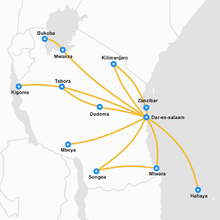
As of August 2018, Air Tanzania serves three international and ten domestic destinations from its hub at Dar es Salaam's Julius Nyerere International Airport.
Fleet
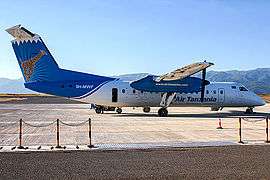
Current fleet
As of July 2018, the airline's fleet consists of the following aircraft:[70][71]
| Aircraft | In Service | Orders | Passengers | Notes | ||
|---|---|---|---|---|---|---|
| C | Y | Total | ||||
| Airbus A220-300 | — | 2[72] | TBA | 127[73] | Deliveries in November 2018[74] | |
| Boeing 787-8 | 1[75] | 1[76] | 22 | 240 | 262[77] | Delivery starts from June 2018 |
| Bombardier Q300 | 1 | — | — | 50 | 50 | |
| Bombardier Q400 | 3 | — | — | 76 | 76 | |
| Total | 5 | 3 | ||||
Historical fleet
Air Tanzania previously operated the following aircraft:[71]
Accidents and incidents
- 1 March 2010: An Air Tanzania Boeing 737-200 (5H-MVZ) skidded off a wet runway while attempting to land at Mwanza Airport. Its nose wheel collapsed and its hull and righthand engine were damaged, but no injuries were reported.[78] The aircraft proved too expensive to repair and is stored in Mwanza pending resolution of a claim with the airline's insurer.[79]
- 8 April 2012: An Air Tanzania de Havilland Canada DHC-8-311Q (5H-MWG) crashed while trying to take-off at Kigoma airport. No one was injured, but the aircraft was irreparably damaged.[80][81]
References
- ↑ https://www.ippmedia.com/en/news/boeing-dreamliner-here
- ↑ "Current Members: ATCL". African Airlines Association. Retrieved 24 December 2013.
- ↑ "Air Operators – Market Share 2009–2011" (PDF). Tanzania Civil Aviation Authority. 2011. Retrieved 23 December 2013.
- ↑ Bombardier Inc. (2 December 2016). "Bombardier Wins Orders for Two CS300 and One Q400 Aircraft from Tanzania". Retrieved 2 December 2016.
- ↑ The Citizen (14 August 2018). "Air Tanzania hits Sh4-5bn revenue per month". Retrieved 14 August 2018.
- ↑ "East African Airways debts total $120 million" (PDF). Flight International: 1713. 10 December 1977. Retrieved 12 June 2013.
- ↑ TAIRO, APOLINARI (4 July 2012). "EXECUTIVE TALK WITH SIR ANDY CHANDE". eTurboNews, Inc. Archived from the original on 14 May 2013. Retrieved 13 June 2013.
- ↑ Ben R. Guttery (1 January 1998). Encyclopedia of African Airlines. Ben Guttery. p. 207. ISBN 978-0-7864-0495-7. Retrieved 12 June 2013.
- ↑ "Air Tanzania History". airtanzania.co.tz. Archived from the original on 6 June 2013. Retrieved 12 June 2013.
- ↑ "Ethiopian Airlines ET-AIZ". Airfleets.net/. Retrieved 13 June 2013.
- ↑ "Alliance Air: A promising airline alliance". African Aviation. January 1995. Archived from the original on 26 April 2014. Retrieved 14 June 2013.
- ↑ "Airline Privatization", Regional Workshop on Air Transport Regulatory Policy, Bangkok, 2000, page 3
- ↑ "$50 million losses forces Alliance Air to close". Flightglobal.com. 17 October 2000. Retrieved 2017-09-04.
- ↑ "Transnet leaves SA Alliance in crisis". Flightglobal.com. 2000-04-11. Retrieved 4 September 2017.
- 1 2 "air tanzania | 2002 | 0541 | Flight Archive". flightglobal.com. Retrieved 4 September 2017.
- ↑ "Press Releases". ifc.org. Retrieved 4 September 2017.
- 1 2 3 4 "Psrctz.com". psrctz.com. Archived from the original on 4 September 2017. Retrieved 4 September 2017.
- 1 2 "Psrctz.com". psrctz.com. Archived from the original on 4 September 2017. Retrieved 4 September 2017.
- ↑ "IFC Home". Retrieved 24 April 2015.
- ↑ "Archived copy". Psrctz.com. Archived from the original on 3 March 2016. Retrieved 24 April 2015.
- ↑ Airliner World, March 2005
- ↑ Airliner World, April 2005
- ↑ "Tanzanian Affairs » AIR TANZANIA CO. LTD. COLLAPSES". tzaffairs.org. Retrieved 2017-09-04.
- ↑ "ATCL and SAA Officially Divorced", IPP Media
- ↑ "Uncertainty haunts the troubled ATCL", IPP Media, reported by Polycarp Machira, 13 September 2009
- ↑ http://allafrica.com/stories/200911021313.html. Missing or empty
|title=(help) - ↑ "Air Tanzania should do serious business", IPP Media
- ↑ "What govt didn`t tell on Sonangol, ATCL deal", ippmedia.com, 1 July 2012
- ↑ "ATC Begins To Use Own Ticket Stocks", IPP Media
- ↑ "MPs Want Government To Adequately Fund ATCL Operations", IPP Media
- ↑ "Air Tanzania finally reborn with former...", IPP Media
- ↑ "Air Tanzania Rebrands Its Logo And Aircraft Colors" Archived 10 October 2007 at the Wayback Machine.
- ↑ "Revamped ATC Makes Inaugural Flight To Mwanza", IPP Media Archived 23 June 2007 at Archive.is
- ↑ Thome, Wolfgang H. (14 December 2008). "Air Tanzania CEO: We will be back". eTurboNews. Archived from the original on 22 May 2013. Retrieved 9 January 2013.
- ↑ "Air Tanzania gets thrown a lifeline", eTurboNews, reported by Wolfgang Thome, 5 January 2009
- ↑ "Highly indebted ATCL in pathetic condition", IPP Media, reported by Polycarp Machira, 4 July 2010
- ↑ "Air Tanzania ditches Chinese firm and partners with Air Zimbabwe", The East African, reported by Mike Mande, 5 July 2010
- ↑ "Air Tanzania on the ground as last plane goes for maintenance". eTurbonews. Retrieved 9 January 2013.
- 1 2 "ATCL revival herculean task", IPP Media, reported by Florian Kaijage, 30 October 2011
- ↑ "Air Tanzania in $500m new aircraft plan". The East African. Retrieved 2017-09-04.
- ↑ "Will Air Tanzania's revival plan take off?". Africa Review. Retrieved 2017-09-04.
- ↑ "Aerovista Delivers B737-500 to Air Tanzania for Africa regional flights -". 17 May 2014. Archived from the original on 24 July 2017. Retrieved 24 July 2017.
- ↑ "ATCL suspends Aero Vista contract", Daily News Online Edition, 5 August 2012 Archived 9 September 2012 at the Wayback Machine.
- ↑ "ATCL plane to cost Sh1.1b 3 months", IPP Media, reported by Flodrian Kaijage
- ↑ "Tanzania to prosecute three officials over $41m aircraft leasing scandal", The EastAfrican, 20 April 2013
- ↑ "Fresh battle over Sh 52 billion deal", ippmedia.com, 1 January 2012
- ↑ "ATCL announces plans to resume Dar-Tabora flights", The Citizen, 30 May 2013
- ↑ "AIR TANZANIA STARTS DAR – BUJUMBURA, DAR- MBEYA FLIGHTS - Corporate Digest". corporate-digest.com. Retrieved 2017-07-24.
- ↑ "Tanzania: Omani Consortium to Invest Sh160 Billion in ATCL", Daily News, reprinted on the website of allAfrica.com, 11 January 2013
- ↑ "Oman Consortium Pledges 8-Planes as an Investment to Air Tanzania", Aviation Tanzania, reported by D. M. Stan, August 2013 Archived 4 March 2016 at the Wayback Machine.
- ↑ "Omani firm 8-plane shunt deal a puzzler", The Daily News, 6 May 2014 Archived 24 September 2014 at Archive.is
- ↑ "ATCL, investor to strike deal before end of year", The Citizen, reported by Ludger Kasumuni, 22 May 2014
- ↑ Tairo, Apolinari (3 May 2016). "Dar seeks funds in bid to revamp flag carrier Air Tanzania". The EastAfrican. Nairobi. Retrieved 4 May 2016.
- ↑ Mbashiru, Katare (29 September 2016). "Tanzania: ATCL Heads to Prosperity". Tanzania Daily News via AllAfrica.com. Dar es Salaam. Retrieved 24 July 2017.
- ↑ Marketwired News Releases (27 September 2016). "Air Tanzania Receives Two Bombardier Q400 Aircraft". Toronto: Canadianinsider.com.
- ↑ Ch-Aviation (2 April 2018). "Air Tanzania takes delivery of third Q400". Sydney: Ch-Aviation. Retrieved 8 July 2018.
- ↑ The Citizen Tanzania (3 April 2018). "Tanzania receives third plane to bolster its national carrier". The EastAfrican. Dar es Salaam. Retrieved 8 July 2018.
- ↑ "Bombardier Wins Orders for Two CS300 and One Q400 Aircraft from Tanzania". Bombardier Aerospace. 24 July 2017. Retrieved 8 July 2018.
- ↑ "Boeing: 787 Dreamliner to become part of Air Tanzania fleet". The Boeing Company. 24 July 2017. Retrieved 8 July 2018.
- ↑ Omondi, Charles (8 July 2018). "Boeing delivers first 787 Dreamliner for Air Tanzania". The EastAfrican. Nairobi. Retrieved 8 July 2018.
- 1 2 "Guidelines for the preparation of Annual Plan and Budget for 2012/13" (PDF). The United Republic of Tanzania. Retrieved 24 February 2013.
- 1 2 "Air Tanzania subsidies reach $2.8 million". The East African. Retrieved 2 February 2013.
- 1 2 3 4 5 "The Tanzania Five Year Development Plan 2011/2012-2015/16" (PDF). The United Republic of Tanzania. Archived from the original (PDF) on 20 January 2013. Retrieved 24 February 2013.
- ↑ "Tanzania's troubled airline to resume flights". eTN Global Travel Industry News. Retrieved 2 February 2013.
- ↑ "Air Tanzania Fires 45% of Staff Amid Talks With China Sonangol". Bloomberg. Retrieved 3 February 2014.
- ↑ "Tanzania: Air Tanzania to Resume Flights". East African Business Week. Retrieved 3 February 2014.
- 1 2 3 4 "Background". Air Tanzania. Retrieved 24 September 2017.
- ↑ "Air Tanzania plans Bombardier purchases". eTurboNews . Retrieved 2 February 2014.
- ↑ "Tanzania: ATCL Board Demotes Directors, Managers". Tanzania Daily News via AllAfrica.com. Retrieved 24 September 2017.
- ↑ "ATCL aircraft returns on Dar-Kigoma route". The Citizen. 2 April 2018. Retrieved 18 February 2016.
- 1 2 "Air Tanzania Fleet". Plane Spotters. Retrieved 2 April 2018.
- ↑ Bombardier Inc. (2 December 2016). "Bombardier Wins Orders for Two CS300 and One Q400 Aircraft from Tanzania". Retrieved 2 December 2016.
- ↑ The Guardian (28 April 2017). "Air Tanzania allocation 500bn/- for next financial year". Retrieved 10 April 2018.
- ↑ Andrew McIntosh (12 December 2016). "Tanzania orders a new Boeing 787-8 Dreamliner to expand international flights". Puget Sounds Business Journal. Retrieved 27 January 2018.
- ↑ https://www.ch-aviation.com/portal/news/68757-air-tanzania-adds-maiden-b787-8
- ↑ "Air Tanzania orders 2 Boeing 787-8". ch-aviation. 6 December 2016. Retrieved 6 December 2016.
- ↑ https://www.routesonline.com/news/38/airlineroute/279597/air-tanzania-plans-boeing-787-launch-in-late-july-2018/
- ↑ "Air crash in Mwanza", Tanzanian Affairs, 1 May 2010
- ↑ "Air Tanzania Corporation Ltd", Tanzanian Affairs, 1 September 2010
- ↑ "How 39 cheated death in ATCL plane mishap", The Citizen, 9 April 2012
- ↑ Harro Ranter (9 April 2012). "ASN Aircraft accident de Havilland Canada DHC-8-311Q 5H-MWG Kigoma Airport (TKQ)". Retrieved 24 April 2015.